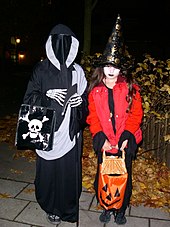Sii pouet_RhieD
JRs

Jumat, 10 Juni 2011
:"(
dan kuwg cari yang lebihh baeg darinya.
ketika ituuu..kuwg mulai mrasakan apa yang tdag prnah kuwg rsakan...
Kamis, 19 Mei 2011
Trick-or-treating and guising

Trick-or-treating is a customary celebration for children on Halloween. Children go in costume from house to house, asking for treats such as candy or sometimes money, with the question, "Trick or treat?" The word "trick" refers to a (mostly idle) "threat" to perform mischief on the homeowners or their property if no treat is given. In some parts of Scotland children still go guising. In this custom the child performs some sort of trick, i.e. sings a song or tells a ghost story, to earn their treats.
The practice of dressing up in costumes and begging door to door for treats on holidays dates back to the Middle Ages and includes Christmas wassailing. Trick-or-treating resembles the late medieval practice of souling, when poor folk would go door to door on Hallowmas (November 1), receiving food in return for prayers for the dead on All Souls' Day (November 2). It originated in Ireland and Britain,[13] although similar practices for the souls of the dead were found as far south as Italy.[14] Shakespeare mentions the practice in his comedy The Two Gentlemen of Verona (1593), when Speed accuses his master of "puling [whimpering or whining] like a beggar at Hallowmas."[15]
In Scotland and Ireland, Guising — children disguised in costume going from door to door for food or coins — is a traditional Halloween custom, and is recorded in Scotland at Halloween in 1895 where masqueraders in disguise carrying lanterns made out of scooped out turnips, visit homes to be rewarded with cakes, fruit and money.[7] The practise of Guising at Halloween in North America is first recorded in 1911, where a newspaper in Kingston, Ontario reported children going "guising" around the neighborhood.[16]
American historian and author Ruth Edna Kelley of Massachusetts wrote the first book length history of the holiday in the U.S; The Book of Hallowe'en (1919), and references souling in the chapter "Hallowe'en in America";
The taste in Hallowe'en festivities now is to study old traditions, and hold a Scotch party, using Burn's poem Hallowe'en as a guide; or to go a-souling as the English used. In short, no custom that was once honored at Hallowe'en is out of fashion now.[17]
In her book, Kelley touches on customs that arrived from across the Atlantic; "Americans have fostered them, and are making this an occasion something like what it must have been in its best days overseas. All Hallowe'en customs in the United States are borrowed directly or adapted from those of other countries".[18]
While the first reference to "guising" in North America occurs in 1911, another reference to ritual begging on Halloween appears, place unknown, in 1915, with a third reference in Chicago in 1920.[19]
The earliest known use in print of the term "trick or treat" appears in 1927, from Blackie, Alberta, Canada:
Hallowe’en provided an opportunity for real strenuous fun. No real damage was done except to the temper of some who had to hunt for wagon wheels, gates, wagons, barrels, etc., much of which decorated the front street. The youthful tormentors were at back door and front demanding edible plunder by the word “trick or treat” to which the inmates gladly responded and sent the robbers away rejoicing.[20]
The thousands of Halloween postcards produced between the turn of the 20th century and the 1920s commonly show children but do not depict trick-or-treating.[21] The editor of a collection of over 3,000 vintage Halloween postcards writes, "There are cards which mention the custom [of trick-or-treating] or show children in costumes at the doors, but as far as we can tell they were printed later than the 1920s and more than likely even the 1930s. Tricksters of various sorts are shown on the early postcards, but not the means of appeasing them".[22] Trick-or-treating does not seem to have become a widespread practice until the 1930s, with the first U.S. appearances of the term in 1934,[23] and the first use in a national publication occurring in 1939.[24]
[edit] Costumes

Halloween costumes are traditionally modeled after supernatural figures such as monsters, ghosts, skeletons, witches, and devils. Over time, the costume selection extended to include popular characters from fiction, celebrities, and generic archetypes such as ninjas and princesses.
Dressing up in costumes and going "guising" was prevalent in Scotland at Halloween by the late 19th century.[7] Costuming became popular for Halloween parties in the US in the early 20th century, as often for adults as for children. The first mass-produced Halloween costumes appeared in stores in the 1930s when trick-or-treating was becoming popular in the United States.
Halloween costume parties generally fall on, or around, 31 October, often falling on the Friday or Saturday prior to Halloween.
[edit] UNICEF
"Trick-or-Treat for UNICEF" has become a common sight during Halloween in North America. Started as a local event in a Northeast Philadelphia neighborhood in 1950 and expanded nationally in 1952, the program involves the distribution of small boxes by schools (or in modern times, corporate sponsors like Hallmark, at their licensed stores) to trick-or-treaters, in which they can solicit small-change donations from the houses they visit. It is estimated that children have collected more than $118 million for UNICEF since its inception. In Canada, in 2006, UNICEF decided to discontinue their Halloween collection boxes, citing safety and administrative concerns; after consultation with schools, they instead redesigned the program.[25][26]
[edit] Games and other activities

There are several games traditionally associated with Halloween parties. One common game is dunking or apple bobbing, in which apples float in a tub or a large basin of water and the participants must use their teeth to remove an apple from the basin.[27] A variant of dunking involves kneeling on a chair, holding a fork between the teeth and trying to drop the fork into an apple.[28] Another common game involves hanging up treacle or syrup-coated scones by strings; these must be eaten without using hands while they remain attached to the string, an activity that inevitably leads to a very sticky face.
Some games traditionally played at Halloween are forms of divination. A traditional Scottish form of divining one's future spouse is to carve an apple in one long strip, then toss the peel over one's shoulder. The peel is believed to land in the shape of the first letter of the future spouse's name.[29] Unmarried women were told that if they sat in a darkened room and gazed into a mirror on Halloween night, the face of their future husband would appear in the mirror. However, if they were destined to die before marriage, a skull would appear. The custom was widespread enough to be commemorated on greeting cards[30] from the late 19th century and early 20th century.
Another game/supersition that was enjoyed in the early 1900s involved walnut shells. People would write fortunes in milk on white papter. After drying, the paper was folded and placed in walnut shells. When the shell was warmed, milk would turn brown therefore the writing would appear on what looked like blank paper. Folks would also play fortune teller. In order to play this game, symbols were cut out of paper and placed on a platter. Someone would enter a dark room and was ordered to put her hand on a piece of ice then lay it on a platter. Her "fortune" would stick to the hand. Paper symbols included: dollar sign-wealth, button-bachelorhood, thimble-spinsterhood, clothespin- poverty, rice-wedding, umbrella- journey, caldron-trouble, 4-leaf clover- good luck, penny-fortune, ring-early marriage, and key-fame.[31]
The telling of ghost stories and viewing of horror films are common fixtures of Halloween parties. Episodes of television series and Halloween-themed specials (with the specials usually aimed at children) are commonly aired on or before the holiday, while new horror films are often released theatrically before the holiday to take advantage of the atmosphere.
Rabu, 03 November 2010
Bersama dia kuw tertawa
 pagi yang cerah..
pagi yang cerah..Smansa Masamba
Sma Negeri 1 masamba merupakan sma terfavorit di Luwu Utara dengan program pendidikan gratisnya. Smansa juga terkenal dengan kebersihan yang dimiliki. Selain itu ada juga ekskul* yang membawa nama smansa masamba ini. Seperti, Basket, Drumband, Volly, footsal, PMR, Dsb. Namun, Yang menjadi beban di smansa yaitu kurangnya fasilitas yang memadahi, dan juga siswa yang terbawa arus dengan kehidupan zaman sekarang sehingga kurangnya perhatian belajar. Kita sebagai siswa Smansa masamba harus menaati peraturan-peraturan sekolah. Seperti melengkapi atribut-atribut, Dsb.
Banyak alumni smansa yang sukses. Ada yang pernah menjadi calon bupati yaitu bapak Arsyad Kasmar, ada juga yang pernah menjadi bupati Luwu Utara yaitu Bapak Lutfi amutti. Wahh..kita sebagai siswa smansa mestinya bangga donk…! Kita haruus bisa menjadi yang terbaik sekolah kita. Mudah-mudahan penerus kita nanti ada yang jdii presiden (amiiiiiinnnnnnn!!!!!!).
Jumat, 06 Agustus 2010
menjadii yg trbaiik
akuuw haruus terbiasaaa untuuk tdaak melawaan mamah_papah...
karenaaa akuuw yakiin krna tnpa doa mamah daan papah akuw tidaak akaan spertii inii....
makasiih mamah-papah..
akuuw saiank kaliaand...
Minggu, 20 Juni 2010
Senin, 14 Juni 2010
it's Me

- pUtry Anadhita Prayoga
- Palopo, Palopo, Indonesia
- saiia hannya manusia biasa yang bisa syg sama orang apa adanya.. namuwn saiiah paliing membenci hal yang namanya menunggu. hal ini membuat sayaa bisa membenci seseorang dengan pkrjaan trsebutt.!. dan 1 lagii,,saiiah saiiaank sangaadth samaa "Ied" ied adalah slah satu oraang syg sm sy.. diia orangnya slaluw memberikan yaang terbaik buat saya.. diia slalu membuat saiaah semangat dalam hal apapun...!!! sampai skarang ini,saiiank dan cintakuuw masiih seetia dengand "IED" dimatakuuwg diia nampak perfect... smpaaii kpandpuun...saiiaaah tag akand pernaah melepaskaand ygg namanyaa"Ied" hannya diiah penyemangaaat hidupquwg.!.
